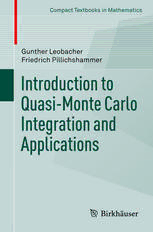Table Of ContentCompact Textbooks in Mathematics
Gunther Leobacher
Friedrich Pillichshammer
Introduction to
Quasi-Monte Carlo
Integration and
Applications
Compact Textbooks in Mathematics
Forfurthervolumes:
http://www.springer.com/series/11225
CompactTextbooksinMathematics
This textbook series presents concise introductions to current topics in math-
ematics and mainly addresses advanced undergraduatesand master students.
Theconceptistooffersmallbookscoveringsubjectmatterequivalentto2-or
3-hourlecturesorseminarswhicharealsosuitableforself-study.Thebookspro-
videstudentsandteacherswithnewperspectivesandnovelapproaches.They
featureexamplesandexercisestoillustratekeyconceptsandapplicationsofthe
theoreticalcontents.Theseriesalsoincludestextbooksspecificallyspeakingto
theneedsofstudentsfromotherdisciplinessuchasphysics,computerscience,
engineering,lifesciences,finance.
Gunther Leobacher
Friedrich Pillichshammer
Introduction to
Quasi-Monte Carlo
Integration and
Applications
GuntherLeobacher FriedrichPillichshammer
InstituteofFinancialMathematics UniversityofLinz
UniversityofLinz Linz,Austria
Linz,Austria
ISBN978-3-319-03424-9 ISBN978-3-319-03425-6(eBook)
DOI10.1007/978-3-319-03425-6
SpringerChamHeidelbergNewYorkDordrechtLondon
LibraryofCongressControlNumber:2014945104
2010MathematicsSubjectClassification:11K06,11K38,11K45,65C05,65D30
(cid:2)c SpringerInternationalPublishingSwitzerland2014
Thisworkissubjecttocopyright.AllrightsarereservedbythePublisher,whetherthewholeorpartof
thematerialisconcerned,specificallytherightsoftranslation,reprinting,reuseofillustrations,recitation,
broadcasting,reproductiononmicrofilmsorinanyotherphysicalway,andtransmissionorinformation
storageandretrieval,electronicadaptation,computersoftware,orbysimilarordissimilarmethodology
nowknownorhereafterdeveloped.Exemptedfromthislegalreservationarebriefexcerptsinconnection
with reviews or scholarly analysis or material supplied specifically for the purpose of being entered
and executed on a computer system, for exclusive use by the purchaser of the work. Duplication of
this publication or parts thereof is permitted only under the provisions of the Copyright Law of the
Publisher’slocation,initscurrentversion,andpermissionforusemustalwaysbeobtainedfromSpringer.
PermissionsforusemaybeobtainedthroughRightsLinkattheCopyrightClearanceCenter.Violations
areliabletoprosecutionundertherespectiveCopyrightLaw.
Theuseofgeneraldescriptivenames,registerednames,trademarks,servicemarks,etc.inthispublication
doesnotimply,evenintheabsenceofaspecificstatement,thatsuchnamesareexemptfromtherelevant
protectivelawsandregulationsandthereforefreeforgeneraluse.
While the advice and information in this book are believed to be true and accurate at the date of
publication,neithertheauthorsnortheeditorsnorthepublishercanacceptanylegalresponsibilityfor
anyerrorsoromissionsthatmaybemade.Thepublishermakesnowarranty,expressorimplied,with
respecttothematerialcontainedherein.
Coverdesign:deblik,Berlin
Printedonacid-freepaper
SpringerispartofSpringerScience+BusinessMedia(www.springer.com)
To CharlotteandGisi
Preface
While Fubini’s theoremstates that the integralof a functionon the s-dimensional
unit cube can be computedsimply by computingiterated integrals, the attemptof
doing so for a function for which those integrals cannot be given by closed-form
formulasisinmostcasesdoomedtofail,ifs,say,isgreaterthan10.Thereasonfor
thisisthatbyiterationofaone-dimensionalintegrationrulethenumberoffunction
evaluationneededforthecorrespondingproductrulegrowsexponentiallyins.
Thisconstraintonthepracticalcomputationofintegralsledtothedevelopment
of probabilistic methods.Here, the integralis interpretedas the expectedvalue of
the integrand evaluated at a random variable that is uniformly distributed on the
s-dimensional unit cube. These methods were first applied by E. Fermi, S. Ulam
andJ.vonNeumann,thelatteralsobeingtheoriginatorofthename“MonteCarlo
simulation”.
In contrast to Monte Carlo integration rules, which sample the integrand at
randompoints,so-calledquasi-MonteCarlorulesusedeterministicsamplepoints.
The relationship between Monte Carlo and quasi-Monte Carlo correspondsto the
relationshipbetweentwonotionsof“uniformdistribution”inmathematics.Thefirst
istheprobabilisticnotionofarandomvariableforwhichtheprobabilityoftaking
values in a given subset of the unit cube is precisely the volume of that set. The
secondnotionisthatofasequenceofpoints,forwhichtheproportionofpointsof
thesequencelyinginagivens-dimensionalsub-intervaloftheunitcubeequalsthe
volumeofthesub-interval.
While the notion of uniformlydistributed sequences and examples thereof had
beencoinedearlier,thebirthofthetheoryof“UniformDistributionModuloOne”
ismarkedbyH.Weyl’sseminalpaper“U¨berdieGleichverteilungmod.Eins”,first
publishedintheyear1916.Itwasalreadyknownbythenthat,atleastinprinciple,
uniformly distributed sequences could be used to integrate Riemann-integrable
functions. However, under the weak assumptions the convergence of the sample
meantotheintegralcanbearbitrarilyslow,makingthe“method”impractical.
Asthestartingpointfortheanalysisofquasi-MonteCarlomethodsfornumerical
integration one can consider the establishment of the Koksma-Hlawka inequality,
which was shown by J.F. Koksma in 1942 for the one-dimensional case and
by E. Hlawka in 1961 for arbitrary dimensions. Since then the Koksma-Hlawka
inequality is the prototypicalerror estimate for quasi-Monte Carlo integration. Its
mainfeatureisthatitboundstheintegrationerrorbytheproductoftwoterms,the
vii
viii Preface
variationof the functionandthe star discrepancyof the underlyingsample nodes.
Thesecondnotionisrelatedtothatofuniformdistributionofasequence,butwhile
thelatterisanasymptoticquality,thestardiscrepancyallowstoassessthequalityof
uniformityofafinitenumberofpoints.Knowinghowwellthepointscanbechosen
with respect to that measure means – thanks to the Koksma-Hlawka inequality –
knowingthe possible convergenceof the integrationerror.This is where concepts
fromDiscrepancyTheoryenterthegame.
Fromtheearly1960sonseveralpeople,amongtheseN.M.Korobov,E.Hlawka,
I.M. Sobol’, J. Halton, H. Faure, H. Niederreiter and C.P. Xing provided con-
structions of point sets and sequences with excellent distribution properties, i.e.,
with low star discrepancy or related/alternative quality measures. The point sets
and sequences constructed in this way are therefore suitable sample points for
quasi-Monte Carlo rules. However, a certain disadvantageous dependence of the
discrepancy bounds on the dimension led to the belief that quasi-Monte Carlo
rulescanonlybeappliedinverymoderatedimensions.Contrarytotheseopinions,
quasi-MonteCarlorulesare nowadaysusedfornumericalintegrationof functions
in hundreds or even thousands of dimensions, and since recently there is also a
stream of research which studies infinite-dimensional integration. The motivation
forthisparadigmchangeliesinresultsofnumericalexperimentspublishedin1995
byS.H.PaskovandJ.F.Traub,whostudiedquasi-MonteCarlorulesforfunctions
in360dimensionscomingfromMathematicalFinance.But,despitetheirapparent
effectivityevenforthose veryhigh-dimensionalproblems,the questionofexactly
whyquasi-MonteCarlorulesshouldgivethesegoodresultsisstillnotcompletely
resolved. In 2010, at the MCQMC meeting in Warsaw, I.H. Sloan spoke in this
context about “The unreasonable effectiveness of quasi-Monte Carlo”. Although
in the meantime some partial answers come from the study of weighted function
spacesandfromtractabilitytheory,thequestforanexplanationofthisunreasonable
effectivenessofquasi-MonteCarloisstillaveryactivepartofresearch.
Assuggestedbyitstitle,thisbookisanintroductorytexttoquasi-MonteCarlo
methods and some of their applications, and it aims at giving a comprehensible
treatmentofthesubjectwithdetailedexplanationsofthebasicconcepts.Originating
froma2-honesemesterundergraduatecourse,itshouldbeaccessibletostudentsin
mathematicsorcomputersciencewithbasicknowledgeofalgebra,calculus,linear
algebra,andprobabilitytheory.Althoughthemainfocusisonthetheorybehindthe
conceptsofquasi-MonteCarlo,severalpracticalapplicationswithanemphasison
financialproblemsarediscussed.
Thetopicsofthebookroughlyretracethehistoryofquasi-MonteCarlomethods
as sketched above, but do so using up-to-date concepts and notations. Thus we
start with the classical multi-dimensional integration problem and its first high-
dimensionalalternative,Monte Carlo integration.Chapter 2 is devotedto uniform
distributionofsequencesandseveralconceptsofdiscrepancy.Wegiveadiscrepancy
estimateforoneoftheoldestspecimensoflowdiscrepancysequences,theHalton
sequence. In Chap.3 we introduce the modern framework of reproducing kernel
Hilbertspaces forobtainingboundson the integrationerrorfor functionsin those
spaces. The Koksma-Hlawka inequality, though not in its most general form,
Preface ix
appearsasaspecialcaseofthattheory.Thenexttwochaptersaremostlydevotedto
constructionsoflow-discrepancypointsetsandsequences,namelylatticepointsets,
.t;m;s/-netsand.t;s/-sequences.Thechapteronlatticerulesincludesasectionon
integrationinweightedKorobovspaces.Theconceptofweightedspaceshassome
bearingontheissueofeffectivenessofquasi-MonteCarlomethodsforveryhigh-
dimensionalproblems.Chapter6concludesthetheoreticalpartbyprovidingmore
informationaboutthecurseofdimensionalityandtractabilityofdiscrepancy.
The last two chapters constitute the application part of the book. Chapter 7
gives a very condensed introduction to concepts from Mathematical Finance, in
particular derivative pricing. We introduce some models and derivatives that can
serve as specimens for trying out the simulation methods provided in Chap.8.
This last chapter coverssome of the basics of simulation, like generation of non-
uniform random variables and generation of Brownian paths. The emphasis is on
(fast-)orthogonaltransformsfor speedingupconvergence.Severalexamplesserve
toillustratethemethods.
The compilationofa textbookdemandsa greatdealnotonlyfromtheauthors,
but also from their families, colleagues, and students, some of the common time
of which has to be diverted to the project. We want to thank all of them for their
supportandunderstanding.
We appreciatevaluablecomments,suggestionsandimprovementsfromseveral
colleagues which we would like to mention here: Josef Dick, Aicke Hinrichs,
PeterKritzer,GerhardLarcher,HaraldNiederreiter,KlausRitterandWolfgangCh.
Schmid.
We hope that the book will turn out to be useful for teaching, self-study, and
asareference,andthatitwillencouragemanypeopletostudyquasi-MonteCarlo
methodsand/orapplythemtoproblemsfromMathematicalFinanceorotherareas.
Linz,Austria GuntherLeobacher
October2013 FriedrichPillichshammer

